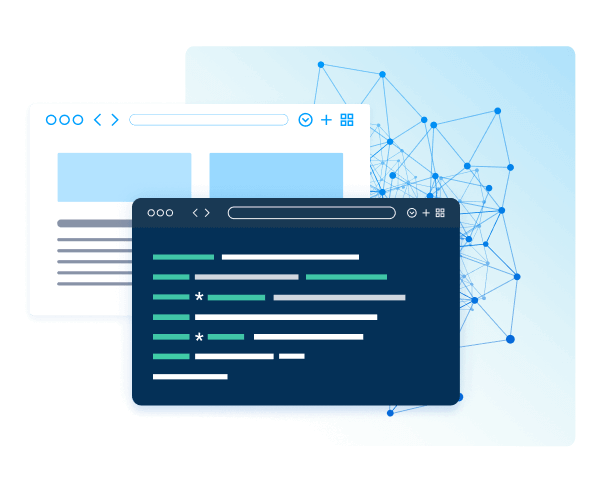Discover how a bimodal integration strategy can address the major data management challenges facing your organization today.
Get the Report →Connect live data from any source to any application
No data movement required
Enable live data access between the data sources and applications powering your business with standards-based connectors for ODBC, JDBC, and more — plugged directly into your tools.
Try them freeWhy CData Drivers & Data Connectors
Connect to every application
Use the same SQL-based connectivity to access hundreds of data sources and applications.
Access your data, your way
CData supports every major driver and adaptor technology, including ODBC, JDBC, ADO.NET, Python, Excel, SSIS, and more.
Benefit from unmatched performance
Get blazing-fast access to data for BI, reporting, and data integration with highly optimized read/write performance.
Get enterprise-level connectivity
Over 7,000 of the world's largest enterprises rely on CData's tried-and-true connectivity tools, which boast features like dynamic metadata, caching, replication, remoting, and query pushdown.
Available data source connectors
Connect your BI, analytics, ETL, & custom applications with any SaaS, NoSQL, or big data source.
(API Driver)
Just data connectors or a platform solution?
With CData, you have the option of plugging data drivers directly into your apps for live access, or building connections within a central cloud platform.
Data drivers & connectors
CData Drivers and Connectors offer direct, live connectivity between applications and data sources.
Features include:
- Support for hundreds of cloud and on-premises data sources
- Extends any application that supports common data interfaces like ODBC, JDBC, ADO.NET, etc.
- Direct point-to-point data connectivity
- Fully-embeddable and available for commercial distribution
Best for:
- One specific connection point
- On-prem or hybrid tech stack
One platform for all your data connections
CData Connect Cloud gives you the same powerful connectivity across all CData Drivers, plus the governance, security, and management features critical for scaling enterprises and cloud-native organizations.
Features include:
- No complicated data pipelines required, just live data connections
- Integrates with 300+ popular cloud applications and clients
- Enables users to configure and connect from multiple applications from within one central platform
- Zero-maintenance data connectivity with pre-built data sources managed transparently
Best for:
- Many connection points
- Cloud-native tech stack
- Self-service user interface
CData Drivers streamline reporting, data integration, and data management
Santa Clara University Connects to Workday to Visualize Historical Student Data
“It was going to be a real problem — pulling all this data out into Excel files, then having to join, manipulate, combine them. I'm sure if anybody works in data, you know that that process is prone to error. It would have been an unenviable process.”
— Conor Roycroft
Director of Institutional Research, Santa Clara University
Read case study

BJ's Wholesale Club Improves Employee Retention by Over 10% with CData
“CData has definitely made our lives easier, because now we have 1,500 leaders in the field that we need to disseminate data to. And we do that through Tableau today. Getting that data from Workday to those users easily wouldn't be possible without CData.”
— Chris Arnold
BJ's Wholesale Club Senior Director of Analytics, Clubs & Online
Read case study

Office Depot Leans on CData to 'Lift & Shift' Critical Data and Enable Analytics Integration
“In a very short amount of time we had the drivers installed, working, and building our analytics cubes on a daily basis. We installed the driver, we pointed the cubes at Snowflake using the driver, and we were up and going.”
— Terry Campbell
Office Depot Sr. IT Manager
Read case study

Technical features
Connect any application to any data source
Broad access to hundreds of enterprise data sources, including every accounting or collaboration tool, CRM, ERP, marketing automation platform, API, database, or data warehouse that matters to you.
Enable self-service data analytics and integration
Rapid data insights and agility, with frictionless access to operational data to support data scientists, business analysts, reporting, low-code developers, and other non-technical users.
Free IT resources from building & maintaining custom integrations.
Eliminate architectural complexity. Stop coding integrations against one-off API and continuously maintaining every single integration. Standards-based drivers provide a logical data layer of abstraction that shields you from the complexity of data access.
Deliver next generation connected applications.
Simplify integration and speed solution delivery. CData Drivers eliminate the time and expense of integrating disparate systems allowing developers to simplify architectural complexity and build connected applications more quickly.
Easily customizable and configurable
The data model exposed by CData Drivers can easily be customized to add or remove tables/columns, change data types, etc. without requiring a new build. These customizations are supported at runtime using human-readable schema files that are easy to edit.
Certified compatibility*
CData Drivers and data connectors undergo extensive testing and are certified to be compatible with leading analytics and reporting applications like Tableau, Microsoft Excel, and many more.
*Please visit our knowledge base to access how-to articles.
Embedded SQL engine
All CData Drivers include a highly evolved client-side query execution engine with full support for SQL-92 operations that are not available at the data source. The drivers seamlessly handle converting SQL queries into an optimized set of instructions for each data source. Any data manipulation that cannot be pushed to the data source is handled transparently via the embedded engine.
Read/write operations (CRUD support)
Whenever possible, drivers include full support for read and write operations with each data source. Stored procedures are made available for data sources where APIs operations are not easily modeled around table updates.
Pushdown, batch, & bulk operation
Pushdown query optimization pushes SQL operations down to the server whenever possible, increasing performance. High-performance features include streaming forward cursors for performance and BatchAPI for efficient INSERT/UPDATES.
Collaborative query processing
CData Drivers enhance the capabilities of each data source with additional client-side processing when needed to enable analytic summaries of data, such as SUM, AVG, MAX, MIN, etc.
Comprehensive metadata discovery
Full support for metadata provides extensive schema discovery capabilities. Explore tables, columns, keys, and more based on user identity.
String, date, numeric SQL functions
All CData Drivers include a library of 50+ functions that can manipulate column values into the desired result. Popular examples include Regex, JSON, and XML processing functions.
Enterprise-class, secure connectivity
Secure connectivity through modern cryptography, including TLS 1.2, SHA-256, ECC, etc.
Frequently asked questions
Common questions about data connectors
What are data connectors?
Data connectors are software middlemen that act as bridges between different data sources and data destinations. They ferry information between various systems, allowing them to talk to each other and share data seamlessly. Connectors simplify the process of integrating data from multiple sources, saving time and effort compared to manual data extraction and transformation.
What is the difference between a connector and a driver?
Data connectors and drivers are both related to data access and movement, but there are some key differences.
A connector is a software library, tool, or platform that facilitates the programmatic access to systems provided by APIs. Connectors try to make it easier for IT teams, developers and other data consumers to access the data. Unlike a driver, a Data Connector tends to offer connectivity tailored to a specific client application or use case.
Drivers, on the other hand, help establish a common semantic layer that simplifies the ingestion, curation, and orchestration of siloed data. Drivers create a common database abstraction on top of applications and data, leveraging established driver interfaces like JDBC, ODBC, and ADO.NET to standardize how applications connect with data. Leveraging a traditional database metaphor to support integration, Drivers provide tables, views, and stored procedures, that map to resources and operations exposed by each source. By piggybacking on universal database driver standards, Drivers act as a real-time universal translator between data consumers (Data Governance, Data Prep, Data Integration, Master Data Management, AI & ML, Data Catalog, Data Warehousing, Data Science, BI, Analytics, and even developer technologies like Low-code integration) and all the applications and data sources used across an organization.
Instead of having to code integrations against one-off APIs and continuously stay up to date on every single API change, standards-based drivers, provide a layer of abstraction and protection from the constantly shifting elements. Drivers offer a tactical approach, augmenting existing integration, processing, and analytics tooling to support broad data access capabilities
Learn more: Drivers vs. Connectors: Diving Deeper into Standards-Based Connectivity.





